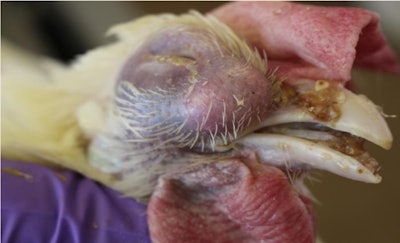
Forty-six U.S. poultry flocks have been affected by infectious coryza so far in 2019, according to Sherrill Davison, DVM, avian medicine and pathology professor at the University of Pennsylvania. This is 24 more flocks than were affected when Davison spoke at the Midwest Poultry Federation Convention in March.
Infectious coryza is a bacterial disease caused by Avibacterium paragallinarum that affects chickens' respiratory systems.
Of those 46 affected flocks, 29 of them have been layer flocks, three of them pullet flocks and 14 broiler flocks.
"We are not quite sure at this time the reason behind why the layers are more affected,” she said.
She has been speaking with researchers from the New Bolton Center Hospital at Penn Vet and from Pennsylvania State University to look at various ways it may be spreading and why it may be more prominent in layers.
“One of the research projects we are going to do here at New Bolton Center at the University of Pennsylvania is really looking at manure and how long the organism can last in manure," she said. "We know in the laboratory it has been a little difficult to grow this bacteria so we are not sure how long it stay in manure, but we have a student that will be looking at that aspect of it and is that one aspect that could be involved with the potential spread."
Davison said biosecurity measures have been increased in order to help combat the situation.
“All the companies have really looked critically at biosecurity, including the companies that transport birds, companies that do the vaccination and have filled in any gaps that they feel are necessary,” she said.
When Davison addressed this topic in March, vaccine supplies were very limited, but are now more readily available.
“We were able to get some of the commercial vaccine from one company and we will be getting 2 million more doses from a different company,” she said. She added that the autogenous vaccine should be available the middle of June.
At this time, the rate of mortality for infected birds is still being calculated, but she confirmed the disease creates an increased death rate.
“I think the industry in Pennsylvania has always been very proactive at looking at these kinds of situations and we work together -- the universities, diagnostic labs, the industry, the Departments of Agriculture (both at state and national level) -- to try and solve these situations.”
She is still waiting to hear back from several sources on whether the disease is active in other states at this time.
Signs of coryza
Clinically, the disease presents itself with signs of respiratory disease. The birds will have facial swelling, swollen wattles, mucoid nasal discharge and respiratory rales. It has a short incubation cycle of one to three days and tends to run its course within two to three weeks, unless otherwise complicated by other bacteria or viruses. A very high mortality, low feed consumption, and a large drop in egg production are consistent with infectious coryza.
When birds are first infected, they have a clear mucus discharge, which then turns milky white and eventually it becomes a caseous material, Davison said. While performing necropsies of deceased birds, Davison found hemorrhages at the distal end of the trachea. She also saw things that looked like infectious laryngotracheitis.
The birds also displayed caseous pericarditis, perihepatitis, egg yolk peritonitis, regressing ovaries and empty gizzards. She said the first clinical signs of coryza is a decrease in feed and water consumption. Older birds seem to be more seriously impacted than younger birds.

















